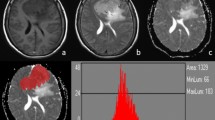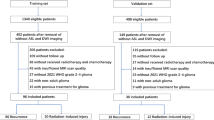Abstract
Purpose
Meningiomas are mainly benign tumors, though a considerable proportion shows aggressive behaviors histologically consistent with atypia/anaplasia. Histopathological grading is usually assessed through invasive procedures, which is not always feasible due to the inaccessibility of the lesion or to treatment contraindications. Therefore, we propose a multi-parametric MRI assessment as a predictor of meningioma histopathological grading.
Methods
Seventy-three patients with 74 histologically proven and previously treated meningiomas were retrospectively enrolled (42 WHO I, 24 WHO II, 8 WHO III) and studied with MRI including T2 TSE, FLAIR, Gradient Echo, DWI, and pre- and post-contrast T1 sequences. Lesion masks were segmented on post-contrast T1 sequences and rigidly registered to ADC maps to extract quantitative parameters from conventional DWI and intravoxel incoherent motion model assessing tumor perfusion. Two expert neuroradiologists assessed morphological features of meningiomas with semi-quantitative scores.
Results
Univariate analysis showed different distributions (p < 0.05) of quantitative diffusion parameters (Wilcoxon rank-sum test) and morphological features (Pearson’s chi-square; Fisher’s exact test) among meningiomas grouped in low-grade (WHO I) and higher grade forms (WHO II/III); the only exception consisted of the tumor-brain interface. A multivariate logistic regression, combining all parameters showing statistical significance in the univariate analysis, allowed discrimination between the groups of meningiomas with high sensitivity (0.968) and specificity (0.925). Heterogeneous contrast enhancement and low ADC were the best independent predictors of atypia and anaplasia.
Conclusion
Our multi-parametric MRI assessment showed high sensitivity and specificity in predicting histological grading of meningiomas. Such an assessment may be clinically useful in characterizing lesions without histological diagnosis.
Key points • When surgery and biopsy are not feasible, parameters obtained from both conventional and diffusion-weighted MRI can predict atypia and anaplasia in meningiomas with high sensitivity and specificity. • Low ADC values and heterogeneous contrast enhancement are the best predictors of higher grade meningioma |


Similar content being viewed by others
Abbreviations
- CE:
-
Contrast enhancement
- HGM:
-
High-grade meningioma
- LGM:
-
Low-grade meningioma
- IVIM:
-
Intravoxel incoherent motion
- VIBE:
-
Volumetric interpolated breath-hold examination
- PTE:
-
Peritumoral edema
- CapE:
-
Capsular enhancement
- TBI:
-
Tumor-brain interface
- AUC:
-
Area under the curve
References
Louis DN, Perry A, Reifenberger G, von Deimling A, Figarella-Branger D, Cavenee WK, Ohgaki H, Wiestler OD, Kleihues P, Ellison DW (2016) The 2016 World Health Organization classification of tumors of the central nervous system: a summary. Acta Neuropathol 131(6):803–820
Perry A, Louis DN, Scheithauer BW, Budka H, von Deimling A. Meningiomas. In: David N Louis, et al, editors. (2000) WHO classification of tumors of the central nervous system. Lyon: IARC p. 164–172
Buetow MP, Buetow PC, Smirniotopoulos JG (1991) Typical, atypical, and misleading features in meningioma. Radiographics. 11(6):1087–1106
Moliterno J, Cope WP, Vartanian ED, Reiner AS, Kellen R, Ogilvie SQ, Huse JT, Gutin PH (2015) Survival in patients treated for anaplastic meningioma. J Neurosurg 123(1):23–30
Wen PY, Quant E, Drappatz J, Beroukhim R, Norden AD (2010) Medical therapies for meningiomas. J Neuro-Oncol 99(3):365–378
Louis DN, Ohgaki H, Wiestler OD, Cavenee WK, Burger PC, Jouvet A, Scheithauer BW, Kleihues P (2007) The 2007 WHO classification of tumors of the central nervous system. Acta Neuropathol 114(2):97–109
Chen CC, Hsu PW, Erich Wu TW et al (2009) Stereotactic brain biopsy: single center retrospective analysis of complications. Clin Neurol Neurosurg 111(10):835–839
Schipmann S, Brix T, Varghese J, Warneke N, Schwake M, Brokinkel B, Ewelt C, Dugas M, Stummer W (2019) Adverse events in brain tumor surgery: incidence, type, and impact on current quality metrics. Acta Neurochir 161(2):287–306
Kawahara Y, Nakada M, Hayashi Y, Kai Y, Hayashi Y, Uchiyama N, Nakamura H, Kuratsu JI, Hamada JI (2012) Prediction of high-grade meningioma by preoperative MRI assessment. J Neuro-Oncol 108(1):147–152
Aslan K, Gunbey HP, Tomak L, Incesu L (2018) The diagnostic value of using combined MR diffusion tensor imaging parameters to differentiate between low- and high-grade meningioma. Br J Radiol 91(1088):20180088
Yiping L, Kawai S, Jianbo W, Li L, Daoying G, Bo Y (2017) Evaluation parameters between intra-voxel incoherent motion and diffusion-weighted imaging in grading and differentiating histological subtypes of meningioma: a prospective pilot study. J Neurol Sci 372:60–69
Bohara M, Nakajo M, Kamimura K, Yoneyama T, Fukukura Y, Kiyao Y, Yonezawa H, Higa N, Kirishima M, Yoshiura T (2020) Histological grade of meningioma: prediction by Intravoxel incoherent motion histogram parameters. Acad Radiol 27(3):342–353
Lin BJ, Chou KN, Kao HW, Lin C, Tsai WC, Feng SW, Lee MS, Hueng DY (2014) Correlation between magnetic resonance imaging grading and pathological grading in meningioma. J Neurosurg 121(5):1201–1208
Zhang S, Chiang GC, Knapp JM et al (2019) Grading meningiomas utilizing multiparametric MRI with inclusion of susceptibility weighted imaging and quantitative susceptibility mapping. J Neuroradiol S0150-9861(19):30162–30162
Abdel-Kerim A, Shehata M, El Sabaa B, Fadel S, Heikal A, Mazloum Y (2018) Differentiation between benign and atypical cranial meningiomas. Can ADC measurement help? MRI findings with hystopathologial correlation. Egypt J Radiol Nucl Med 49(1):172–175
Surov A, Ginat DT, Sanverdi E, Lim CCT, Hakyemez B, Yogi A, Cabada T, Wienke A (2016) Use of diffusion weighted imaging in differentiating between maligant and benign meningiomas. A Multicenter Analysis. World Neurosurg 88:598–602
Le bihan D (2019) What can we see with IVIM MRI? Neuroimage 187:56–67
Tini P, Nardone V, Pastina P, Battaglia G, Vinciguerra C, Carfagno T, Rubino G, Carbone SF, Sebaste L, Cerase A, Federico A, Pirtoli L (2017) Perilesional edema in brain metastasis from non-small cell lung cancer (NSCLC) as predictor of response to radiosurgery (SRS). Neurol Sci 38(6):975–982
Coroller TP, Bi WL, Huynh E, Abedalthagafi M, Aizer AA, Greenwald NF, Parmar C, Narayan V, Wu WW, Miranda de Moura S, Gupta S, Beroukhim R, Wen PY, al-Mefty O, Dunn IF, Santagata S, Alexander BM, Huang RY, Aerts HJWL (2017) Radiographic prediction of meningioma grade by semantic and radiomic features. PLoS One 12(11):e0187908
Watanabe Y, Yamasaki F, Kajiwara Y, Takayasu T, Nosaka R, Akiyama Y, Sugiyama K, Kurisu K (2013) Preoperative histological grading of meningiomas using apparent diffusion coefficient at 3T MRI. Eur J Radiol 82(4):658–663
Surov A, Hamerla G, Meyer HJ, Winter K, Schob S, Fiedler E (2018) Whole lesion histogram analysis of meningiomas derived from ADC values. Correlation with several cellularity parameters, proliferation index KI 67, nucleic content, and membrane permeability. Magn Reson Imaging 51(March):158–162
Hale AT, Wang L, Strother MK, Chambless LB (2018) Differentiating meningioma grade by imaging features on magnetic resonance imaging. J Clin Neurosci 48:71–75
Palaniandy K, Haspani MSM, Zain NRM (2017) Prediction of histological grade and completeness of resection of intracranial meningiomas: role of peritumoural brain edema. Malays J Med Sci 24(3):33–43
Gawlitza M, Fiedler E, Schob S, Hoffmann KT, Surov A (2017) Peritumoral brain edema in meningiomas depends on Aquaporin-4 expression and not on tumor grade, tumor volume, cell count, or Ki-67 labeling index. Mol Imaging Biol 19(2):298–304
Ng WH, Hy JW, Tan WL, Liew D, Lim T, Ang BT, Ng I (2009) Aquaporin-4 expression is increased in edematous meningiomas. J Clin Neurosci 16(3):441–443
Cornelius JF, Slotty PJ, Steiger HJ, Hänggi D, Polivka M, George B (2013) Malignant potential of skull base versus non-skull base meningiomas: clinical series of 1,663 cases. Acta Neurochir 155(3):407–413
Adeli A, Hess K, Mawrin C, Streckert EMS, Stummer W, Paulus W, Kemmling A, Holling M, Heindel W, Schmidt R, Spille DC, Sporns PB, Brokinkel B (2018) Prediction of brain invasion in patients with meningiomas using preoperative magnetic resonance imaging. Oncotarget. 9(89):35974–35982
Kalamarides M, Stemmer-rachamimov AO, Niwa-kawakita M et al (2011) Identification of a progenitor cell of origin capable of generating diverse meningioma histological subtypes. Oncogene. 30(20):2333–2344
Hoover JM, Morris JM, Meyer FB (2011) Use of preoperative magnetic resonance imaging T1 and T2 sequences to determine intraoperative meningioma consistency. Surg Neurol Int 2:142
Li H, Zhao M, Jiao Y, Ge P, Li Z, Ma J, Wang S, Cao Y, Zhao J (2016) Prediction of high-grade pediatric meningiomas: magnetic resonance imaging features based on T1-weighted, T2-weighted, and contrast-enhanced T1-weighted images. World Neurosurg 91:89–95
Zhang H, Rödiger LA, Shen T, Miao J, Oudkerk M (2008) Perfusion MR imaging for differentiation of benign and malignant meningiomas. Neuroradiology. 50(6):525–530
Zampini MA, Buizza G, Paganelli C, Fontana G, D’Ippolito E, Valvo F, Preda L, Baroni G (2020) Perfusion and diffusion in meningioma tumors: a preliminary multiparametric analysis with dynamic susceptibility contrast and IntraVoxel incoherent motion MRI. Magn Reson Imaging 67:69–78
Essig M, Shiroishi MS, Nguyen TB, Saake M, Provenzale JM, Enterline D, Anzalone N, Dörfler A, Rovira À, Wintermark M, Law M (2013) Perfusion MRI: the five most frequently asked technical questions. AJR Am J Roentgenol 200(1):24–34
Qiao XJ, Kim HG, Wang DJJ, Salamon N, Linetsky M, Sepahdari A, Ellingson BM, Pope WB (2017) Application of arterial spin labeling perfusion MRI to differentiate benign from malignant intracranial meningiomas. Eur J Radiol 97:31–36
Juratli TA, Thiede C, Koerner MVA, Tummala SS, Daubner D, Shankar GM, Williams EA, Martinez-Lage M, Soucek S, Robel K, Penson T, Krause M, Appold S, Meinhardt M, Pinzer T, Miller JJ, Krex D, Ely HA, Silverman IM, Christiansen J, Schackert G, Wakimoto H, Kirsch M, Brastianos PK, Cahill DP (2017) Intratumoral heterogeneity and promoter mutations in progressive/higher-grade meningiomas. Oncotarget. 8(65):109228–109237
Acknowledgements
The authors would like to thank our patients and their families for participating in our research.
Funding
No funding was received for this study.
Author information
Authors and Affiliations
Corresponding author
Ethics declarations
Conflict of interest
The authors declare that they have no conflict of interest.
Ethical approval
All procedures performed in the studies involving human participants were in accordance with the ethical standards of the institutional and/or national research committee and with the 1964 Helsinki Declaration and its later amendments or comparable ethical standards.
Informed consent
Informed consent was obtained from all individual participants included in the study.
Additional information
Publisher’s note
Springer Nature remains neutral with regard to jurisdictional claims in published maps and institutional affiliations.
Rights and permissions
About this article
Cite this article
Sacco, S., Ballati, F., Gaetani, C. et al. Multi-parametric qualitative and quantitative MRI assessment as predictor of histological grading in previously treated meningiomas. Neuroradiology 62, 1441–1449 (2020). https://doi.org/10.1007/s00234-020-02476-y
Received:
Accepted:
Published:
Issue Date:
DOI: https://doi.org/10.1007/s00234-020-02476-y




